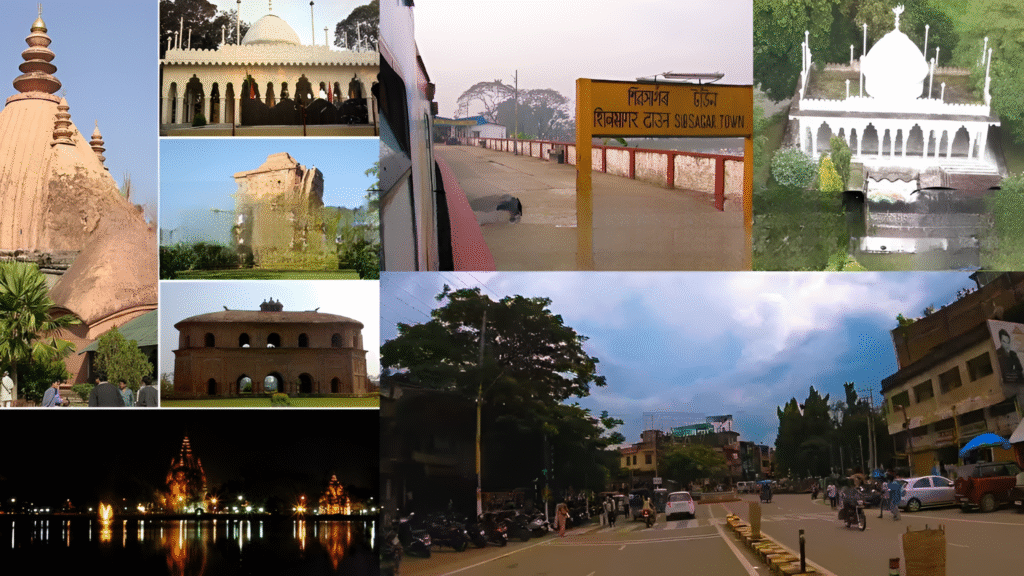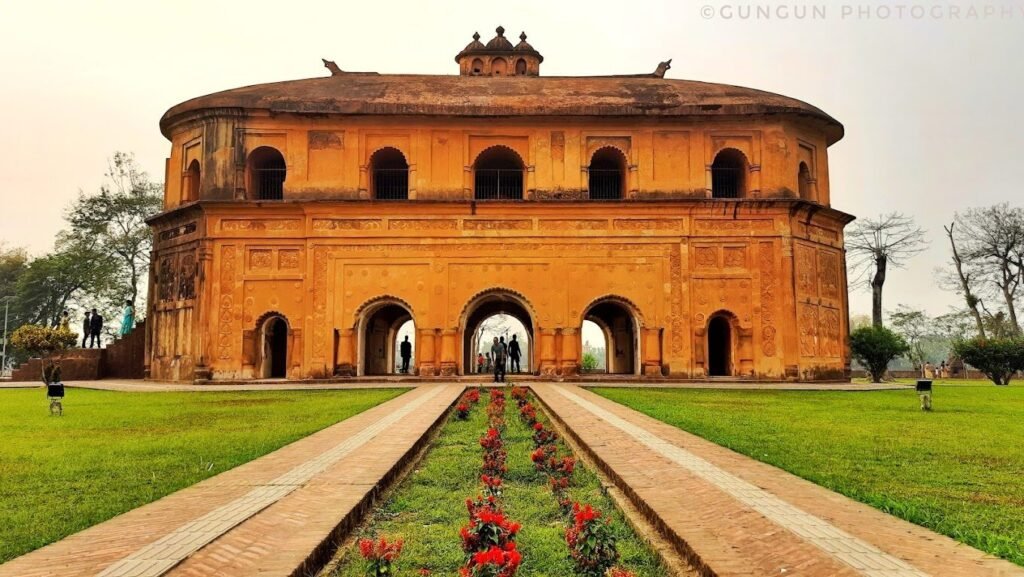Sivasagar stands as one of India’s most remarkable heritage towns, blending centuries of Ahom dynasty history, stunning architecture, vibrant culture, and scenic beauty into a must-visit destination. Situated in upper Assam, Sivasagar’s name is synonymous with the legendary Ahom Kingdom and the spirit of Assam’s ancient grandeur.
Location and Geographic Details
- Region: Upper Brahmaputra Valley, Assam, India.
- Coordinates: Approx. 26°59′N 94°38′E.
- Administration: Structured into subdivisions; important revenue circles like Amguri.
Travel Routes and Location Guide
It is conveniently located in the upper Brahmaputra Valley, approximately 369 km from Guwahati. It is well-connected, making travel easy by air, train, and road:
- By Air: Nearest airports are Rowriah (Jorhat, 60 km), Dibrugarh (80 km). Regular flights connect to major Indian cities.
- By Train: Sibsagar Town Railway Station on the Lumding-Dibrugarh route welcomes several trains.
- By Road: Scenic road journeys from Guwahati (361 km), Dibrugarh (76 km), Jorhat (57 km), Dhemaji (127 km) offer diverse vistas of Assam.
Key Details:
Top Tourist Places, Timings, and Entry Cost
Ancient History of Sivasagar
Sivasagar, formerly known as Rangpur, served as the glorious capital of the Ahom Kingdom from 1699 to 1788. The Ahoms, an influential Tai-speaking dynasty, ruled Assam for nearly six centuries, shaping the region’s development and identity. Their reign was distinguished by robust administration, military acumen, and patronage of art, literature, and architecture. The town’s transformation from ‘Kalansupar’ and ‘Shivpur’ into ‘Sivasagar’ marks a tapestry of cultural evolution, British colonial annexation in 1826, and continuing legacy even after the administrative headquarters moved to Jorhat in 1912.
- Sivasagar’s historical monuments, including tanks, temples, and palaces, are living testimonies of Ahom engineering prowess and their enduring impact on Assam’s civilisation.
Key Historical Milestones
- Capitals: Rangpur, later renamed Sivasagar, was the Ahom capital from the late 17th through the 18th centuries.
- Colonisation: Post-1826, British authorities reorganised the region, establishing new administrative divisions and preserving Ahom artefacts.
- Cultural Legacy: Sivasagar remains central to the identity of Assam, celebrated for its Ahom monuments and living traditions.
Rich Cultural Tapestry
Sivasagar is a vibrant blend of multiple ethnic groups, including Mishing, Naga, Manipuri, Garo, and Deori people. This peaceful coexistence has fostered a unique confluence of art, folklore, traditional costumes, and cuisine. The town’s spiritual identity is deeply associated with Hinduism and Vaishnavism, as seen in its revered temples and the influence of saints like Srimanta Sankardeva and Sri Madhabdeva.
- The art and festivities in Sivasagar reflect centuries-old traditions merged with new influences from different communities.
- Music, dance, and handicrafts occupy a significant place in Sivasagar’s cultural scene, drawing visitors into its welcoming atmosphere.
Tourist Attractions: What to See in Sivasagar
Sivasagar houses some of Assam’s finest historical and natural sites, each echoing the town’s magnificent past and scenic allure. Here are the top places that every traveller must explore:
Economy and Revenue
Sivasagar’s economy is driven by agriculture, oil, tea, and tourism. Area development schemes, especially for dairy and pig farming, provide significant employment and are highly profitable, with pig farming IRR reported at over 55%. The region has several revenue circles, like Amguri, covering hundreds of square kilometres under well-managed local governance.
- Oil and tea industries form the backbone of local revenue, attracting investments and supporting livelihoods.
Sivasagar’s Modern Significance
Today, Sivasagar is much more than its historical roots. It’s a centre for research, education, and ongoing news, such as the October 2025 case involving Assam’s beloved singer Zubeen Garg, whose passing sparked public emotion and political action in Sivasagar. The region continues to emerge as a cultural and economic hub in Assam, drawing tourists, historians, and cultural enthusiasts from across the country.

List of Must-Visit Places in Sivasagar
- Rang Ghar
- Talatal Ghar
- Sivadol (Shiva Dol)
- Vishnu Dol
- Devi Dol
- Joysagar Tank
- Rudrasagar Tank
- Gaurisagar Tank
- Charaideo Maidams
- Namdang Stone Bridge
- Ahom Museum
- Pani Dihing Wildlife Sanctuary
- Chalapothar Shyam Gaon
- Ajan Pir Dargah
Sivasagar: The Soul of Assam’s Heritage
Sivasagar encapsulates the spirit of Assam through its monumental history, harmonious communities, striking architecture, and enthralling attractions. The town invites travellers not only to witness its past but also to partake in its present, through local festivals, historical tours, wildlife excursions, and cultural events that continue to enliven this legendary land.
Recent News
As Sivasagar mourns the tragic loss of music legend Zubeen Garg, the district’s vibrancy and heritage once again shift to the spotlight. Calls for transparent investigation and heartfelt tributes highlight its enduring role as Assam’s cultural diamond, bridging the historic Ahom legacy and contemporary social consciousness. Local leaders and communities rally to honour both the past and present, reaffirming Sivasagar’s place in the cultural crossroads of India
FAQs About Sivasagar
What is the historical significance of Sivasagar?
It served as the capital of the Ahom Kingdom for nearly a century and was pivotal in ancient Assam’s administration and culture.
What are the top tourist attractions in Sivasagar?
Rang Ghar, Talatal Ghar, Sivadol, Joysagar Tank, and Pani Dihing Wildlife Sanctuary are among the most famous spots, each representing unique history or natural beauty.
How can travellers reach Sivasagar?
Visitors can reach Sivasagar by air via Jorhat/Dibrugarh airports, by train to Sivasagar Town station, and by scenic road routes from various Assamese towns.
What makes Sivasagar’s culture unique?
The peaceful coexistence of diverse ethnic groups and the influence of Ahom dynasty traditions lend Sivasagar its multicultural identity, reflected in local art, cuisine, and festivals.
What economic activities drive Sivasagar’s revenue?
Agriculture, oil, tea, tourism, and livestock development (including modern farming schemes) collectively generate substantial revenue for the region.
What is the best season to visit Sivasagar?
October to March is best for travel, as the climate is pleasant, and most festivals and attractions are accessible.
Are there modern facilities and accommodations in Sivasagar?
Yes, it offers various hotels, guesthouses, and travel guides for tourists, making it easy to explore both heritage sites and natural retreats.
How is Sivasagar relevant in recent news?
The town was featured in headlines around cultural icon Zubeen Garg’s passing in 2025, reflecting its continued role in Assam’s cultural affairs and public discourse.
